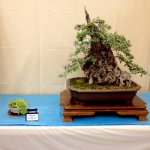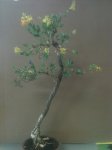Here's what I understand. Along the gulf coast, both alata and crassifolia produce corky wings. They can be difficult to tell apart:
- Cedar elms don't bark as prolifically as Winged elm
- The underside of the leaf on a Cedar elm tends to be rough to the feel - winged elm is less so
- You can tell definitively by blooming time. Crassifolia (cedar elm) are one of only two native fall blooming elms (the September elm is the only other). Ulmus parvifolia also blooms in the fall. All other natives bloom in spring.
Because of the difference in seasonal blooming time, the cedar elm doesn't hybridize with other elms. But I think that the winged elm will readily cross with other spring-blooming natives (americana and rubra are the only other two that grow natively in Texas). Because of this, species characteristics can be unreliable and identification really difficult.
However, you can nail cedar ID if they are blooming. So I know the cedars I've collected are cedars because they were in a grove of fall blooming elms. I've never seen this tree bloom, but it does cork much more prolifically than the trees I know are cedars and the bark has really different character. So I strongly suspect it's a Winged elm, not a cedar. But I'm not a botanist and can't be sure unless it blooms. If it is a Winged elm - it's also possible that its got some American elm in its genes, but I'd have no idea how to tell.
In the end, it doesn't really matter - other than the blooming, the culture is identical. Wire new growth in spring (branches thicken rapidly during the growing season). Be VERY careful of the wire cutting in. Remove wire and cut back once the branches set and repeat. We get 2-3 growth cycles a season. Grow in a well-draining soil mix - they respond vigorously to fertilization, so for developed trees, withhold fertilizer until after the spring growth has hardened off.
- Scott















